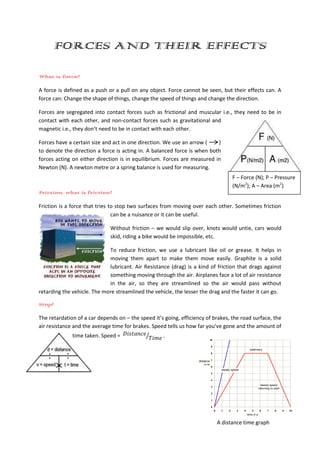
Forces and their effects
- 1. FORCES AND THEIR EFFECTS What is force? A force is defined as a push or a pull on any object. Force cannot be seen, but their effects can. A force can: Change the shape of things, change the speed of things and change the direction. Forces are segregated into contact forces such as frictional and muscular i.e., they need to be in contact with each other, and non-contact forces such as gravitational and magnetic i.e., they don’t need to be in contact with each other. Forces have a certain size and act in one direction. We use an arrow ( ) to denote the direction a force is acting in. A balanced force is when both forces acting on either direction is in equilibrium. Forces are measured in Newton (N). A newton metre or a spring balance is used for measuring. F – Force (N); P – Pressure (N/m2); A – Area (m2) Friction, what is friction? Friction is a force that tries to stop two surfaces from moving over each other. Sometimes friction can be a nuisance or it can be useful. Without friction – we would slip over, knots would untie, cars would skid, riding a bike would be impossible, etc. To reduce friction, we use a lubricant like oil or grease. It helps in moving them apart to make them move easily. Graphite is a solid lubricant. Air Resistance (drag) is a kind of friction that drags against something moving through the air. Airplanes face a lot of air resistance in the air, so they are streamlined so the air would pass without retarding the vehicle. The more streamlined the vehicle, the lesser the drag and the faster it can go. Stop! The retardation of a car depends on – the speed it’s going, efficiency of brakes, the road surface, the air resistance and the average time for brakes. Speed tells us how far you’ve gone and the amount of time taken. Speed = . A distance time graph
- 2. Will it float? Objects float on water due to upthrust. Gravity pulls all objects down to the centre of the earth (this pull is the weight of the object). Upthrust pushes upward against the weight (force of gravity). According to Archimedes principle, ‘for totally immersed objects the volume of the fluid displaced by the object is equal to its own volume. If the density of the immersed object is more than that of the fluid, the object will sink as the weight of the body is more than the upward thrust. If the density of the object is less than that of the fluid, it floats in the fluid partially submerged.’ In simpler terms, it means, ‘If the density of the object is more than that of the fluid, the object will sink, whereas if the density is lesser, the object will float.’ Density is the mass per unit area. It is calculated by dividing Mass by the volume. The 3 density of water is 1g/cm . Weight in science Gold, which has a density of 3 In science, weight and mass are different things. Mass is the amount of 17.31g /cm , will sink because matter in an object and is measured in kilograms. Weight is a force and the density is more than that of water. Wood’s density is is measured in N (Newton). Weight is the force due to gravitational pull 3 0.7g/cm , so wood will float on of the Earth. The force of gravity on a mass of a 1 kg ball is 10N water. towards the Earth. Gravity is the force of attraction between two objects that have mass. The bigger the object, the bigger the force of attraction. Even small objects will attract, albeit it won’t be that powerful. Since weight is caused due to gravity, the weight can differ in places in the universe. For instance, since the radius of the moon is 6 times smaller than that of the Earth, your weight will be one-sixths of what it is on Earth. Whereas, mass remains the same everywhere.